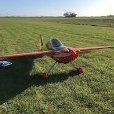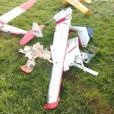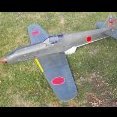Leaderboard
Popular Content
Showing content with the highest reputation on 05/04/23 in all areas
-
It's not unusual to have a red kite come over to share a thermal with my models at our local field. They often fly in really close formation, but they just seem curious rather than aggressive. Here's an image from some onboard video I took about a year ago. I posted the video on YouTube if anyone's interested. The picture below is the model I used for the video.3 points
-
Managed to dust the cobwebs off my SkyWing Edge 540 74" this morning after the last flight on October 2022. Instruments seem to be working fine! All good to go. chilly, but with a light crosswind. Hey! That's what the rudder's for! After the third flight of four I was happy enough to remind myself of flat & inverted spins after loosening up with some stall turns and knife edges. I forgot what a precise flier she is. Great morning.3 points
-
I thought that it w as. They have a family living in the woods nearby,have done for years. Yesterday there was some discussion as the which it was. I thought it was a Red Kite. One of them once attacked my MAK 15 MP which, as you can see looked very rd kite like3 points
-
3 points
-
I found an old indoor clothes hanger leaning againt a bin for collection. I took it away and cleaned it up a little. I drilled a couple of extra holes and used self tapping screws to make it height adjustable. I added some rubber stoppers to the ends of the legs/arms. I added foam water pipe lagging to the arms. One hour later, hey presto, one simple but functional model stand. Total cost, less than 5 euros for the rubber stoppers and pipe lagging.3 points
-
One thing I do like about building wings is that you get a lot of model for your effort. A couple of hours after starting and you could convince yourself that the wing is almost finished! The carbon fibre tubes used for the spars and the leading edge add great strength to the structure, even at this stage of construction. Wing tips are very vulnerable to “hanger rash” but this method makes them really “ding” proof and is also reasonably light. The core is 1/16th balsa, cut undersize by the appropriate amount, and then layers of 1/64th ply are glued to the edge; to match the carbon fibre leading edge I’ve used 5 layers of 5mm strips. Using just 3 layers of 1/64th ply would be sufficient to make a really tough wing tip.2 points
-
As (I assume) it would have its OP ID attached, you should be able to reassure him that no news is good news on that front.2 points
-
I think you'll eventually find that moving the tank (or mounting the engine sideways) will be needed. Might as well get it over with before struggling with a badly adjusted motor...2 points
-
Well I am doing a tidy up in the shed over the weekend. I'm looking to make some reasonable working space again. The shed has become a bit of a " catch all " since just before last winter. My Indian Scout Bobber motorcycle has been stored in there overthe winter and other things have just been placed in storage there as well. When tidy, it offers a pretty good workshop area kitted out with a whole host of tools etc. The bike is going up for sale shortly as I dont really get out on it as often as I would like and to justify the cost of keeping it on the road. I need to thin out some of the things I've collected over the years and get my space back. So fingers crossed I can free the space and start my build. I have already advised of my absence from the flying field this weekend to give myself some decent time to get this moving. Cant wait to get started. Toto1 point
-
The Beaufort is one of the lesser known aircraft despite being in action during world wide during the whole war. A while ago I saw a picture of a row of British bombers and couldn't recognise them, Beauforts I found out later. Timo1 point
-
You can use a straight joiner if the slots for its tubes are cut at the dihedral angle in a hardwood spar filler. The first photo is of my Chris Foss 144" span Multi-Phase, the wood is Ramin from a local picture framing shop. The wood is laminated with thin ply, the longer ply part keys in to a vertical slot in the foam wing and glues to its single 1/4" spruce spar. The tube is epoxied in, I seal the open outboard ends with masking tape to stop it seeping in. It's glued in in one piece then cut in half after it's set for accuracy, there is an allowance for a ply root rib to be added, the tube is then filed flush. For a built up wing the wood block can be fitted between the upper and lower spars then closed with ply (Chris Foss Hi-Phase) I used quite large diameter steel rod for the Multi-Phase but for your model a 6 SWG wire joiner and aluminium tube would probably be ok. I have a chart somewhere of the number and size of joiners needed for gliders based on their wing span. Chris's 100" Centi-Phase uses a vertically stacked 6 SWG joiner system the same as this, the second joiner can be left out for gentle flying or not built in at all (i.e. not bungee launching in windy weather). Both designs use a thin incidence peg with aluminium tubes (14 SWG) to keep the root ribs aligned, I flew the Centi-Phase without it once and had a fun time trying to trim out strange roll behaviour!! I use carbon joiners in my competition gliders where they were manufactured with them but prefer piano wire for sport gliders as it only bends on a windy bungee launch, I've snapped carbon joiners before, they let go without warning. 1. Multi-Phase joiner system. 2. Centi-Phase system, upper wire is 6 SWG, lower is 8 SWG (and shorter than the main joiner). The incidence pin can be seen behind them. 3. Centi-Phase root rib. 4. The Hi-Phase uses three 6 SWG joiners, in this photo I have the wing vertical so that epoxy fills the space around the tubes by gravity. I have just added the ply webs fore and aft on the centre joiner. Instead of one piece of wood for the joiner it is short sections filling in between the ribs, hard balsa instead of hardwood. Extra tube is overhanging for the ply root rib to be added later.1 point
-
Some shots of the Leprechaun XL Wing boxes being assembled Shot showing one in the wing Ply joiner / brace in the fuse1 point
-
I'll second that, but watch out! They are lighter Larger capacity for same size case More punchy as the voltage holds up under extreme load than anything else I have had Don't get as hot No one has confirmed this, but IMHO they are a slightly different lipo technology to everything that came before now (tested and the capacity of 4S packs is correct).1 point
-
Graham the OS55AX is a cracking engine I've got one in my Astro Hogg, just follow the instructions, lean it out then come back a couple of clicks, I initially ran mine on 5% (Southern Model crafts) but was given a couple of gallons of straight ( Southern models synthetic) and it runs great on that after a slight retune. I hardly ever use an electric starter on mine just prime it and a few lazy reverse flicks and it's away on the first flight of the day and then 1 or 2 reverse flicks after that. I'm running a 13 x 6.5" prop on mine so probably not getting max performance but it's more than ample for the Astro Hog1 point
-
My 88" span Majestic Major which looks like it has a fairly similar center section is joined together with 3 sets on straight piano wire, 2 on the main spar above each other and 1 towards the trailing edge. Model is 30 or so years old and I don't have the plan anymore. About 5 years ago I did replace the piano wires as the originals had taken on a slight bend increasing the dihedral. On our larger scale vintage gliders we use the brass box section with steel joiner, like these with a pin towards the trailing edge to ensure alignment.1 point
-
Both my Rascal 110” and Leprechaun XL have dihedral with split wing sections. They have. Joiner boxes in each wing section and an aluminium joiner in the case of the Rascal and ply in the Leprechaun. Both use pins to line up the wings, no secondary spar joiners.1 point
-
A model like this, flown mostly low throttle with occasional bursts of power, an 8oz tank will last for ever.1 point
-
When faced with the need for lots of wing ribs, in the case of the SE5a 64 ribs and 72 riblets, cutting them out individually is very time consuming and boring, an easy way is the use the “sandwich method”, which involves fixing several balsa “blanks” between 2 “template” ribs. The root ribs are from 2 layers of 1/16th ply; the first is a “full” rib as shown and then a “skeleton” rib will be glued on when most of the construction is complete When you see the pile of blanks it makes you realise just how many ribs there are! The blanks have the hole for the leading edge drilled, using a very sharp drill bit, a ply rib is taped to a set of blanks using the leading edge carbon fibre tube as a guide before drilling the remaining holes with the drill in a vertical drill stand to make sure the holes are straight. Short lengths of the carbon fibre spars are threaded through the holes and another ply rib is fitted. I did one wing set at a time. Using progressively finer grades of sand paper attached to a straight edge…. …..the ribs are sanded to shape. Be careful when you get close to the ply “template” ribs! The riblets are made in a similar fashion. I’ve made a complete SE5a rib set, I dread to think how long this lot would have taken cutting them out individually! Although it was a relatively easy job to make the 64 identical wing ribs, being an SE5a it’s not as simple as that! In fact every rib needs to be altered; the mass-produced ribs were a conglomerate of all the rib profiles. The 20 “aileron” ribs are cut vertically just behind the rear spar hole, these are the only ones that need the rear support tab, which is removed from the remaining 44 ribs; the riblets also have their support tab removed and are shortened.1 point
-
This is a snippet from the manual. The orange arrow is the front support former for the undercarriage so my normal wing nibble method wont work here. I would remove the red bit as that bay looks a half decent size. Its only an 82, it shouldnt need that much fuel...even if it is a saito 😉 A square slec tank would work well here if the bay is long enough1 point
-
I am not aware of all the details but the basic impression is that the model flew off under power and would continue until it ran out of fuel. Switch failure is being offered as a possible cause so i assume a failsafe was set but did not activate. If the switch did fail or battery disconnect the fail safe would not have had time to function. If the model can be recovered it might shed some light on the failure mode. The chap in question is quite distressed by the event and its potential consequences and questioning his continued participation in the hobby. Finding the model is as much to give him peace of mind it didnt hurt someone as it is about actually getting it back.1 point
-
A nice big hole in the firewall might help matters, if it's a tank with the usual protruding stopper arrangement. Some surgery to the wing leading edge might help too... Jon has posted many examples of mods to warbird wings to drop the tank. As noted, it's only wood.1 point
-
I suspect that the majority of flyaways are caused by battery issues so this wise (and almost universally legally required) precaution wouldn’t help.1 point
-
I dont take any prisoners when it comes to mods of this nature. If a knife wont do then out comes the tenon saw, hammer and chisel. Its only wood 🙂 That said, your options are limited to removing the tank tray ahead of the undercarriage mount former and dropping a tank in there. I dont know how big that bay is but it looks big enough for maybe a 9oz slec tank?1 point
-
They are BS012 Don. If you cant find any send me an sae with a few quids worth of stamps to cover the payment and i will send some back to you. Its not worth putting it on a card1 point
-
Thanks Roy. Am very pleased with the results I got with the foam wing. It was fun working with obechi veneer again, been many years. Am keen to make more foam wings but I think I'll do a Mini Skyman next as per plan. Covering tonight...1 point
-
Lovely shot 👏 Think it is a Red kite, Buzzards have round tails.1 point
-
Aww he will be so sad if we dont play with him. he just wants to be included the conversation but has nothing constructive to add. And look, cant you see the delight in his comments, the joy? he really thinks he is on to something and yes..wait! he has finally scored a point against the great Jon of Laser who made a mistake with his chonky prop....except, he hasnt. Jason, its a test prop and it never leaves the ground. Of course, you know that and just wanted the point to make yourself look big and me look silly by explaining the obvious but for the others that were interested in the actual facts of the matter, there it is. it is pretty chewed up, but then you would be too after more than...good lord i dont know...10 years? and probably over 3000 starts? Most if which are by hand. I would replace it, but they are discontinued and as its structurally fine, meh. All my test data is with this prop too and im not going to do it all again. Would i fly it or recommend anyone does so with a similar prop? absolutely not, is it fine for testing? yes. Its even balanced 🙂1 point
-
Yea the fuel will syphon out of the tank and fill up the intake elbow on the carby. The tank height thing is a common mod for Laser's due to the high carb placement but in this case it will be an issue for all engines. Im actually quite annoyed by this as you (or anyone else) are trying to follow the various instructions to get the job right. but if you follow them it will simply not work as the design is flawed and you are being instructed to do something wrong. For someone who is not that experienced this would be a nightmare as they have done everything by the book and yet have all these problems with their engine and they might even damage it if they crank the electric starter and hydraulic lock the motor. You can shear crank pins doing that. Really not impressive at all.1 point
-
There is a load on that other thread, some of which will not apply but there is a bunch of stuff there. The only thing i would say is to forget the tacho and put it back in the box. Tach's are very useful tools for checking engine performance but they are useless for tuning. peak RPM will vary day to day with temperature, air density etc. Also a cold engine will run faster than a hot one so if you check it 1 minute after starting, tune it up with 20-30 seconds at high power, the rpm will drop due to the engine warming up. You then say 'where did my revs go' and sit there flat out staring at the tach trying to screw all the revs back out of the needle. All the while the engine gets hotter and hotter, and slower and slower. Tach's also do not react fast enough to be of much use. Certainly they are slower than your ears when it comes to detecting a change. The biggest issue i think people have with engines is using their ears to identify issues. We are all used to looking for problems with our eyes, so a tacho seems a good idea, but often the 'secret' language of engines is all in the sound. You just have to learn the language and that takes a little practice.1 point
-
Serious Complaint What's wrong with this world, there I am yesterday up at the flying field in wind and cold with my FT200. Its not been run since last year and just look at what happened! All checks complete, engine primed and the darn thing starts first time and then to add insult, it didn't even need need a tweak in the main needles. just flew around sounding awesome. I even tried flying inverted and bunts, but it was having none of it and just kept running. I landed having cold fingers and it hadn't even used half a tank. I gets worse as after 4 flights it was time to go home and on packing up only found two small and not even patches of wet oil on the fuz. I mean how are you meant to get all the mud off the wing when there is so little oil! What was wrong with the good old days of unreliable engines, hours of freezing your fingers off trying to get it started only to quit with the nose up test or on the take off roll! Its either therapy or start this ASP up I have and let it slobber down the fuz with the smell of castor in the air. With the age old question...when is it going to dead stick on me! Rant over 🤣1 point
-
After the repairs I did five short flights to check if everythings ok and to get myself used to a proper landing pattern. Three weeks later the weather hasn't improved but today I chose an hour without rain (just plenty of wind at low temperatures) to make another testflight. First time up in the air with spinners and the looks are improved considerably! The Whirlwind flew steady despite wind gusts. The improved rudder linkage and reduced control throws helped and I think the spinners reduced turbulence, too. Flight #10 was a great satisfaction since I'm getting used to the model and if flying in strong wind is no problem, I can look forward to spring and summer 🙂 Timo1 point
-
The biggest problem John is manufacturers are dealing with complete idiots. There will always be that one idiot somewhere in the world who runs his engines flat out from the get go using some insanely small/big prop and his own 'special brew' fuel made with beef dripping, moonshine and unicorn tears as its 'better' than that commercial tosh. He then wraps the engine in a blanket and redirects the exhaust onto the head just to make sure it over heats. he's been doing this since 1974 and all the engine failures he suffers are 'manufacturing defects'. He may or may not also think the earth is flat and the government are controlling his mind from orbit using microwaves. While the above is an exaggeration, there will always be 'that guy' somewhere in the world and they are such hard work when it comes to warranty claims manufacturers try to engineer out the idiot with safe recommendations as mechanical failures look really bad. There is also history to consider as a lot of these recommendations and practices go back to the days of bean juice as oil and the problem with bean juice is that it is quite variable in its quality. Machining tolerances of old were not as they are now, materials were not as they are now and yet there is great inertia when it comes to updating practices and recommendations. Just look at all the castor oil arguments on the forum here. On the rpm thing, again i think this is a bit of an overhand from the US market. They usually stick massive (by our standards) engines in small models, tip in 30% nitro and scream around flat out propped for maximum power. It is not uncommon over there for a 60 inch warbird to weigh 17lbs and use a 200 size 4 stroke where as here it would be 9-10lbs and use an 80 or 90. Consequently, if you do a full throttle power dive in your heavy and overpowered model you are going to rev the rod off the engine. They dont all fly like that out there, but i have enough of a laugh about it with US based customers that it seems pretty common! I also suspect that this is partly responsible for the large number of saito radial rod failures. Dont get me wrong, i dont think saito have done their finest work on some of those engines, but i do think modellers treating them like any other 4 stroke is part of the problem. There is great complexity and great mass of whirly parts inside those engines and you can just slap them about like a standard 90fs. That said, saito should know people would thrash them and they should have been built to handle it. Just my opinion on it The same could even be said about the exhaust. If they are known to fall off, maybe design a better one? The old saito engines never had an issue, its the new ones with the heavy cast mufflers that tend to suffer in my experience. So anyway, if you arent 'that guy', you can run your engines much closer to the line when it comes to fuel, oil, tuning, props etc and this brings considerable rewards in reduced cost, mess, fuel consumption, increased engine life, increased power, increased reliability, increased performance... What more can you ask for?1 point
-
After what seemed like weeks of wind or rain the weather gods relented today and I finally managed to test fly my latest rubber powered model. This is the Gollywock, which was designed by Wally Simmers in the 1940's. There were a number of different versions of this design but I based mine on the 6" chord version, the plan of which is available from the Outerzone website https://outerzone.co.uk/plan_details.asp?ID=6653 As my local club flying field has woodland alongside it I've fitted rudder only R/C to keep it out of the trees. This was the first time that I've used Deluxe Materials Eze tissue, which seems pretty tough, has strong colours and has a very high wet strength. It's just a shame that it's not compatible with cellulose dope. Initial flights look very promising, and if we ever get a calm day again I think it should be capable of some long flights.1 point
-
More flights as soon as the weather improves 🙂 Until then, there are plenty of details to improve and to work further on. Timo1 point
-
A quick overview of the repair and strengthening of the wing in January and February. I repaired the broken spar and added a second one. Another one from spruce was placed aft for less torsion. I've had a balsa spar in front of the flaps to keep it light behind the center of gravity, but obviously that wasn't enough for a failed landing. I also increased spar strength on the outer wings to keep overall strength comparable. In the end I was really quick with placing new spars. Lots of Yorshire tea and a bottle of Somerset cider surely helps 😉 Timo1 point





(2020_03_2622_00_27UTC).thumb.gif.375a6ebc5cd681eb724c62879a10ef8d.gif)





